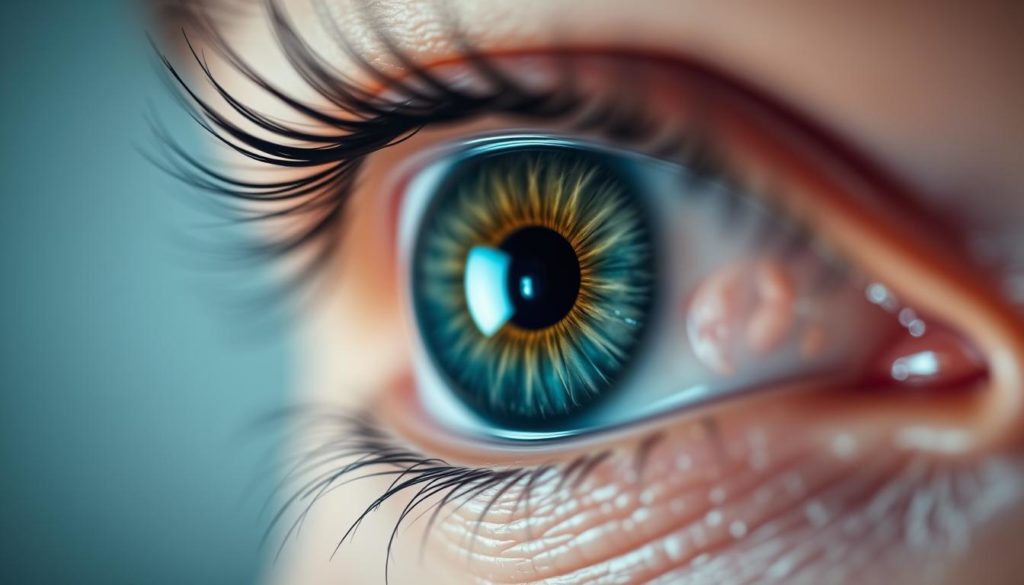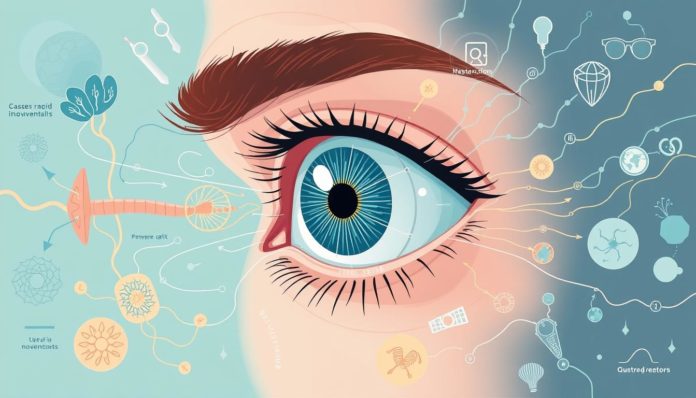Did you know about one in every 1,000 people having nystagmus? This eye condition causes involuntary eye movements. It can really affect how well you see and your overall life quality. Learning about nystagmus is key to dealing with it.
Nystagmus is not just interesting; it’s a serious eye condition. It can happen for many reasons, like genetics or brain problems. Knowing why it happens is important for finding good treatments.
This article will cover everything about nystagmus. We’ll talk about its symptoms, how to get diagnosed, and treatment options. We’ll share the latest medical info and new ways to help those with nystagmus. Our aim is to help you understand and manage your condition better.
What is Nystagmus?
Nystagmus is an eye disorder where the eyes move on their own. These movements can make it hard to see things clearly. It can start at birth, called congenital nystagmus, or happen later, known as acquired nystagmus.

Types of Nystagmus
Knowing the different types of nystagmus is important for treatment. There are two main types:
- Congenital Nystagmus: This type is found soon after birth. It’s often due to genetic problems or eye or brain issues.
- Acquired Nystagmus: This type starts later in life. It can be caused by brain problems, head injuries, or diseases like multiple sclerosis.
Nystagmus in Infants
In babies, congenital nystagmus is the most common. Parents should watch for signs like eye movements that won’t stop, tilting their head, or trouble focusing. Finding and treating it early can help avoid lasting vision impairment.
| Type | Common Causes | Symptoms |
|---|---|---|
| Congenital Nystagmus | Genetic abnormalities, developmental issues | Involuntary eye movements, head tilting |
| Acquired Nystagmus | Neurological conditions, head injuries | Difficulty focusing, vision disturbances |
Nystagmus Overview
Nystagmus is a condition where eyes move quickly without control. It can make seeing things clearly hard. This makes everyday tasks like reading or driving tough. 
Knowing about nystagmus helps keep eyes healthy. Some people might not notice it much, but others face big challenges. That’s why getting eyes checked often is key.
Nystagmus can be different for everyone. It can be mild or very serious. This shows how important it is to learn more about it and keep eyes in good shape.
Here is a table that shows how different types of nystagmus affect vision:
| Type of Nystagmus | Description | Impact on Vision |
|---|---|---|
| Congenital Nystagmus | Present at birth, often inherited | Mild to moderate vision problems |
| Acquired Nystagmus | Develops later due to illness or injury | Significant, varying vision problems |
| Latent Nystagmus | Typically manifesting when one eye is closed | Can cause mild vision disruption |
| Spasmus Nutans | Occurs in infancy, usually resolves over time | Temporary vision issues |
Learning about nystagmus can help catch it early. This can make living with it easier.
Causes of Nystagmus
Nystagmus can come from different sources. These include genetic factors and neurological conditions. Let’s explore each cause to understand it better.
Genetic Factors
Genetics play a big role in nystagmus. Albinism is a genetic disorder that can cause nystagmus. It affects the eyes’ pigmentation. Gene mutations, often inherited, can also lead to congenital nystagmus.
Neurological Conditions
Brain disorders and other neurological issues often cause nystagmus. Conditions like multiple sclerosis or a stroke can affect eye movement control. Inner ear problems can also cause involuntary eye movements.
Medication side effects can sometimes lead to nystagmus as a reaction.
Symptoms of Nystagmus
Nystagmus can really affect your daily life. A big symptom is blurred vision. This happens because your eyes move fast and you can’t focus well. It also causes eye strain as you try to keep your vision steady.
Dizziness is another common sign. The eye movements can mess with your balance. This makes you feel like you’re going to fall over, especially when you move your head quickly.
People with nystagmus often have trouble keeping eye contact. Their eyes might shake or jerk a lot. These signs can get worse when you’re stressed or tired.
Lastly, eye strain is a big problem. Your eyes work hard to keep up with their movements. This can lead to headaches and even seeing double in some cases. Spotting these symptoms early is key to dealing with nystagmus.
Diagnosis of Nystagmus
Diagnosing nystagmus involves detailed exams and tests. These help find the causes and how it affects vision. Doctors use eye and neurological tests to understand the condition fully.
Eye Examinations
Eye exams are key in diagnosing nystagmus. They check how well you see and how your eyes move. Eye tracking technology is used to watch your eye movements closely.
These tests can spot problems early. They help doctors find issues with your eyes.
Neurological Assessments
Neurological tests are also important. They use MRIs or CT scans to see the brain. Neurologists look for any brain problems that might affect your eyes.
This approach helps doctors understand the condition better. It helps them create a good treatment plan for you.
| Diagnosis Method | Procedure | Benefits |
|---|---|---|
| Vision Test | Assess visual clarity and acuity | Identifies vision impairment |
| Eye Tracking | Monitors eye movements | Detects irregular eye patterns |
| Neuroimaging | MRI/CT scans of the brain | Identifies neurological causes |
Treatment Options for Nystagmus
Managing nystagmus can improve your quality of life. There are several treatments available. These include medications, surgeries, and special exercises.
Medications
Medicines like gabapentin and memantine might help reduce nystagmus symptoms. Botulinum toxin injections can also relax eye muscles. This reduces the involuntary eye movements.
Surgical Interventions
For severe cases, surgery might be needed. Tenotomy or prism glasses can improve vision and reduce eye shaking. These surgeries aim to align eye muscles or change how light enters the eyes.
Nystagmus Exercises
Vision therapy exercises can greatly benefit you. They help improve eye movement coordination and control. Using adaptive devices like prism glasses can also help with daily activities.
Living with Nystagmus
Living with nystagmus can be tough, but there are ways to make life better. Learning to adapt to daily life is key. This helps you do well at work and at home.
“Adjusting to life with nystagmus required both patience and creativity. Modifying my workspace and tapping into supportive resources made all the difference.”
Using visual aid equipment is crucial. Magnifiers, special computer software, and good lighting can help a lot. They make everyday tasks easier and reduce eye strain.
- Magnifiers
- Specialized computer software
- Ergonomic lighting
Finding support is also important. Support groups and counseling offer emotional and practical help. They connect you with others who face similar challenges. Joining an advocacy group can also lead to new treatments and support.
| Resource | Description |
|---|---|
| Support Groups | Connect with individuals experiencing similar challenges. |
| Counseling Services | Professional guidance in managing emotional and adjustment issues. |
| Advocacy Groups | Stay informed about the latest treatments and community support. |
By using these strategies and tools, you can manage nystagmus better. This way, you can keep living a fulfilling and productive life.
When to See a Nystagmus Specialist
Knowing when to seek professional help for nystagmus is key. Look out for signs like persistent eye movements, blurred vision, or trouble focusing. These symptoms can really affect your daily life and quality of life. So, getting help quickly is very important.
Seeing a specialist means you get a detailed diagnosis. They use advanced tools and techniques to understand your nystagmus. This helps them create a treatment plan just for you.
When you see a specialist, they’ll do a thorough check-up. They’ll talk about your health history, lifestyle, and symptoms. They might do tests to check your eye movements and could suggest imaging studies if needed. With the right care, you can better manage nystagmus and improve your health.
FAQ
What is nystagmus?
Nystagmus is an eye condition where your eyes move on their own. It can affect how well you see and may start at birth or later in life.
What are the types of nystagmus?
There are two main types. Congenital nystagmus starts in babies. Acquired nystagmus happens later due to health issues or medicine side effects.
How does nystagmus affect infants?
Babies with nystagmus might see things less clearly. It could also mean there’s a health problem. Finding and treating it early is key for their vision.
What are common symptoms of nystagmus?
Symptoms include blurry vision, feeling dizzy, and eye strain. You might also have trouble judging distances and keeping your balance. People with nystagmus often notice their eyes moving without control.
How is nystagmus diagnosed?
Doctors check your eyes and how they move. They might also do tests to see if there’s a problem in your brain or nerves.
What causes nystagmus?
It can be caused by genes, like albinism, or by brain or ear problems. Some medicines and health issues can also cause it.
What treatment options are available for nystagmus?
Doctors might use medicine, surgery, or special eye exercises. Prism glasses and injections can also help.
How can one manage living with nystagmus?
You can adjust your daily life and use special tools. Joining support groups and talking to counselors can also help. Making your environment easier to see can improve your life.
When should I see a nystagmus specialist?
See a specialist if you notice your eyes moving on their own, have vision problems, or feel dizzy. They can figure out what’s wrong and help you get better.


